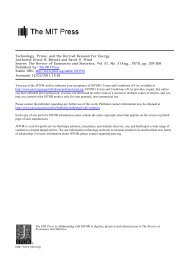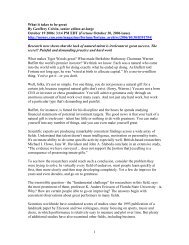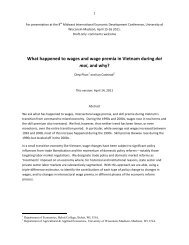Capital-Labor Substitution and Economic Efficiency Author(s): K. J. ...
Capital-Labor Substitution and Economic Efficiency Author(s): K. J. ...
Capital-Labor Substitution and Economic Efficiency Author(s): K. J. ...
You also want an ePaper? Increase the reach of your titles
YUMPU automatically turns print PDFs into web optimized ePapers that Google loves.
The Review of <strong>Economic</strong>s <strong>and</strong> Statistics<br />
VOLUME XLIII AUGUST I96I NUMBER 3<br />
CAPITAL-LABOR SUBSTITUTION AND<br />
ECONOMIC EFFICIENCY1<br />
K. J. Arrow, H. B. Chenery, B. S. Minhas, <strong>and</strong> R. M. Solow<br />
IN many branches of economic theory, it is<br />
necessary to make some assumption about<br />
the extent to which capital <strong>and</strong> labor are sub-<br />
stitutable for each other. In the absence of em-<br />
pirical generalizations about this phenomenon,<br />
theorists have chosen simple hypotheses, which<br />
have become widely accepted through frequent<br />
repetition. Two competing alternatives hold the<br />
field at present: the Walras-Leontief-Har-<br />
rod-Domar assumption of constant input co-<br />
efficients; 2 <strong>and</strong> the Cobb-Douglas function,<br />
which implies a unitary elasticity of substitution<br />
between labor <strong>and</strong> capital. From a mathemati-<br />
cal point of view, zero <strong>and</strong> one are perhaps the<br />
most convenient alternatives for this elasticity.<br />
<strong>Economic</strong> analysis based on these assumptions,<br />
however, often leads to conclusions that are un-<br />
duly restrictive.<br />
The crucial nature of the substitution as-<br />
sumption can be illustrated in various fields of<br />
economic theory:<br />
(i) The unstable balance of the Harrod-<br />
Domar model of growth depends in a critical<br />
way on the asumption of zero substitution be-<br />
tween labor <strong>and</strong> capital, as Solow [I5], Swan<br />
[I8], <strong>and</strong> others have shown.<br />
(ii) The effects of varying factor endow-<br />
ments on international trade hinge on the shape<br />
of particular production functions. In this case,<br />
either zero or unitary elasticities of substitution<br />
in all sectors of the economy lead to Samuelson's<br />
1 This study grows out of the research program of the<br />
Stanford Project for Quantitative Research in <strong>Economic</strong> De-<br />
velopment. It is one in a series of analyses based on inter-<br />
national comparisons of the economic structure. Hendrik<br />
Houthakker contributed substantially to the formulation of<br />
both the statistical <strong>and</strong> theoretical analyses. Arrow's par-<br />
ticipation was aided by Contract 25I(33), Task N4047-co4,<br />
Office of Naval Research.<br />
2 It is only fair to note that the general equilibrium the-<br />
ories of Walras <strong>and</strong> Leontief never assume fixed proportions<br />
for gross aggregates like capital <strong>and</strong> labor.<br />
strong assumption as to the invariability of the<br />
ranking of factor proportions. Variations in<br />
elasticity among sectors imply reversals of fac-<br />
tor intensities at different factor prices with<br />
quite different consequences for trade <strong>and</strong> factor<br />
returns.<br />
(iii) In analyzing the relative shares of in-<br />
come received by the factors of production, it is<br />
tempting to assume unit elasticity of substitu-<br />
tion to agree with the supposed constancy of<br />
the labor share in the United States. Recent<br />
work has called into question both the observed<br />
constancy <strong>and</strong> the necessity of the assumption<br />
[9, I7].<br />
Turning to empirical evidence, we find every<br />
indication of varying degrees of substitutability<br />
in different types of production. Technological<br />
alternatives are numerous <strong>and</strong> flexible in some<br />
sectors, limited in others; <strong>and</strong> uniform substi-<br />
tutability is most unlikely. The difference in<br />
elasticities is confirmed by direct observation of<br />
capital-labor proportions, which show much<br />
more variation among countries in some sectors<br />
than in others.<br />
The starting point for the present study was<br />
the empirical observation that the value added<br />
per unit of labor used within a given industry<br />
varies across countries with the wage rate.<br />
Evidence of this relationship for 24 manufac-<br />
turing industries in a sample of I9 countries is<br />
given in section I. A regression of the labor<br />
productivity on the wage rate shows a highly<br />
significant correlation in all industries <strong>and</strong> also<br />
a considerable variation in the regression coeffi-<br />
cients.<br />
These empirical findings led to attempts to<br />
derive a mathematical function having the prop-<br />
erties of (i) homogeneity, (ii) constant elastici-<br />
ty of substitution between capital <strong>and</strong> labor, <strong>and</strong><br />
(iii) the possibility of different elasticities for<br />
[ 2251







